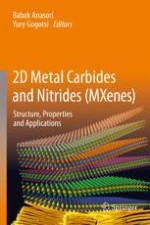2019 | OriginalPaper | Chapter
25. MXenes for Transparent Conductive Electrodes and Transparent Energy Storage Devices
Authors : Chuanfang (John) Zhang, Valeria Nicolosi
Published in: 2D Metal Carbides and Nitrides (MXenes)
Publisher: Springer International Publishing
Activate our intelligent search to find suitable subject content or patents.
Select sections of text to find matching patents with Artificial Intelligence. powered by
Select sections of text to find additional relevant content using AI-assisted search. powered by
